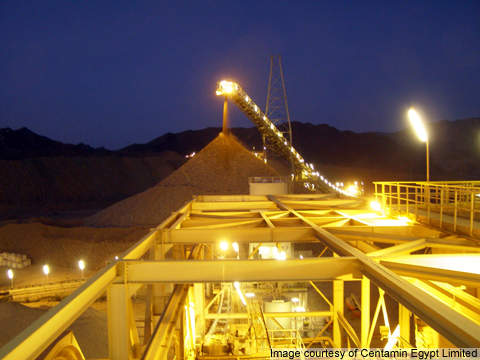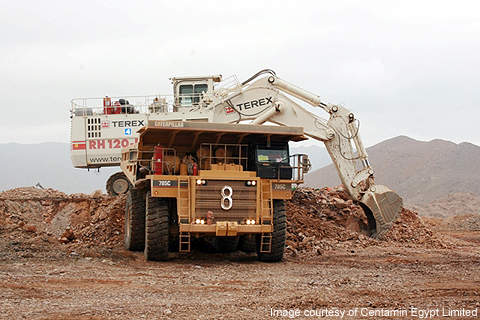The Sukari gold project is located in the eastern desert of Egypt, approximately 23km south-west of Marsa Alam, a coastal town near the Red Sea. The mine occupies an area of 160km2. The project, Egypt’s first large-scale gold mine, is currently in development. Mining began in 2007 and first gold was poured on 26 June 2009, following an expansion of the processing plant.
Sukari Gold Mining Company, a joint venture between Centamin Egypt and the Egyptian Government, operates the mine. The mine will produce 200,000oz of gold in 2010. On 28 March 2010, production at Sukari surpassed 1t of gold.
Reserves
Total reserves at the mine are estimated at 7.1 million ounces of gold. Proven reserves are approximated to be 69.1Mt graded at 1.37g/t Au.
Probable reserves contained within the deposit amount to 90.1Mt graded at 1.41g/t Au. Measured and indicated resources are 210.19Mt at a grade of 1.52g/t Au and inferred resources total 66.3Mt graded at 1.6g/t Au. The cut-off grade is 0.4g/t Au for oxide and sulphide material and 0.5g/t for transitional material.
Geology and mineralisation
The deposit is hosted within a late Neoproterozoic granitoid intrusive complex as a large, covered, vein-type and brittle-ductile shear zone. The zone is characterised by a mass northeast-southwest strike-slip alteration that forms into a regional flower structure. Extensional vein-associated faults also dominate the zone.
Gold mineralisation occurs as a granitoid body composed of granodiorite–tonalite. The mineralised body, known as Sukari porphyry, is associated with sulfides hosted within quartz veins and alteration zones.
The sulphide ore at Sukari is dominated by pyrite and arsenopyrite and also contains trace amounts of sphalerite, chalcopyrite and galena.
Gold is hosted as anhedral grains positioned between zones within the arsenian pyrite as randomly spread anhedral grains found along the fissures in aresenian pyrite and arsenopyrite and as large gold grains that are interstitial to dust-like pyrite and arsenopyrite.
Simultaneous precipitation of gold and arsenic in pyrite and arsenopyrite is a distinct feature of the gold mineralisation at Sukari.
Mining
The deposit is mined using conventional open-pit methods. After the primary and oxide material has been blasted, the ore is transported to the run-of-mine pad adjacent to the processing plant. Mining is carried out at a design capacity of 5Mt of ore per annum. In 2010, at full capacity, four production fleets including include one 380t excavator and 20 150t rigid body trucks will be used.
Underground mine
Underground mine development at Sukari began in April 2009. Construction of the portal and the decline’s descend commenced in July 2009. By the end of March 2010, the main decline, the ventilation decline and infrastructure for an escape way advanced to 1,072m. The decline reached 75m below surface. Initial access to an ore body, hosted 250m below surface, is expected to be achieved by the end of 2010.
Approximately 500,000t of ore graded between 5-10g/t Au will be the initial target for mining. Full production will begin 18 months after the decline begins operations.
Processing
Ore is processed following the typical crushing, grinding and flotation. Bulk sulphide concentrate containing the metals is thickened and milled. Precious metals from the concentrate are leached in a dilute cyanide solution, absorbed onto activated carbon and stripped from the carbon before it is recovered as gold ore. The concentrate tailing that contains substantial gold is placed in a tailings storage facility. Additional gold is recovered by processing the bulk flotation tailings following the same process.
Expansion
To achieve 4Mt/y of throughput, Stage 1 expansion of the processing plant was completed and commissioned in 2009. Commissioning of the stage 2 sulphide circuit commenced in the first quarter of 2010.
During the same period, the design and engineering of Stage 3 expansion that will increase throughput to 5Mt/y was carried out. Scheduled for completion by mid 2011, the expansion will install a second crushing circuit and associated infrastructure which will be integrated to the current crushing circuit of the processing plant.
A scoping study for Stage 4 expansion that will target a throughput rate of 10Mt/y was initiated in the first quarter of 2010. Scheduled for completion by the second half of 2010, the study will determine the most favourable process flow path for the expansion. Stage 4 expansion will be completed in 2012. An estimated $30m will be expended towards stage 3 and 4 expansions in 2010.






